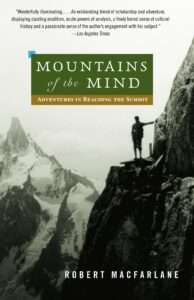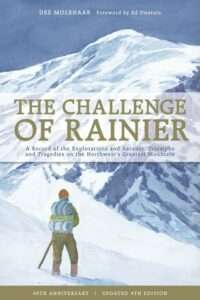“Mountains of the Mind” by Robert Macfarlane is a non-fiction book that explores the history, culture, and psychology of mountains and mountaineering. Macfarlane discusses the ways in which mountains have been perceived and represented in art, literature, and popular culture, and how our relationship with them has changed over time. He also delves into the dangers and allure of climbing, and the impact that mountaineering has had on the landscape and on mountaineers themselves.
Fallen Giants: A History of Himalayan Mountaineering
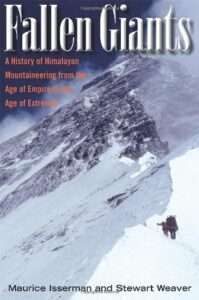
“Fallen Giants: A History of Himalayan Mountaineering” is a book by British mountaineer and historian Maurice Isserman. The book provides an in-depth historical account of the development of mountaineering in the Himalayas, covering significant expeditions and mountaineers from the late 19th century to the present day.
Isserman examines the political, social, and cultural context in which mountaineering developed in the region, and the impact of mountaineering on the people and environment of the Himalayas. The book also explores the risks and challenges of high-altitude mountaineering, as well as the controversies surrounding the commercialization of mountaineering in the region.
Overall, “Fallen Giants” is a comprehensive and engaging account of the history of Himalayan mountaineering, and provides valuable insights into the complex relationship between humans and the world’s highest mountains.
The World Beneath Their Feet: Mountaineering, Madness, and the Deadly Race to Summit the Himalayas
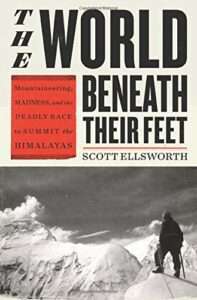
“The World Beneath Their Feet: Mountaineering, Madness, and the Deadly Race to Summit the Himalayas” is a book by New York Times bestselling author Scott Ellsworth. The book tells the story of the race to climb the world’s highest mountains, with a particular focus on the intense competition between British and American climbers in the mid-20th century.
Ellsworth explores the motivations and personalities of the climbers involved, including George Mallory, who famously disappeared on Mount Everest in 1924, and the American climbers who competed with the British for mountaineering supremacy. The book also delves into the psychological and physical toll of high-altitude climbing, including the effects of oxygen deprivation and extreme weather.
Overall, “The World Beneath Their Feet” provides a gripping and insightful account of the history of mountaineering in the Himalayas, as well as the risks and rewards of pursuing the ultimate mountaineering challenge: reaching the summit of Mount Everest.
Fifty Percent of Mountaineering is Uphill
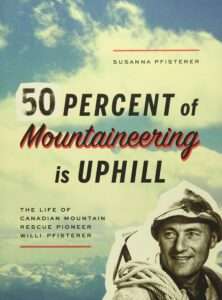
“Fifty Percent of Mountaineering is Uphill” is a book written by British mountaineer and author, Felicity Aston. The book is a memoir of Aston’s experiences while participating in the first all-female team to ski across Antarctica.
In the book, Aston details her journey from being an ordinary person to becoming a seasoned explorer. She discusses the physical and mental challenges that she and her teammates faced during their expedition, including the harsh Antarctic weather conditions and the strain that such a journey can place on a person’s body and mind.
Aston also reflects on the lessons she learned during her journey, such as the importance of perseverance, team collaboration, and positive thinking. The book provides insights into the world of mountaineering and the difficulties and triumphs that come with it.
Overall, “Fifty Percent of Mountaineering is Uphill” is an inspiring and engaging read that will appeal to anyone interested in adventure, exploration, and personal growth.
Memoirs of a Dinosaur Mountaineer
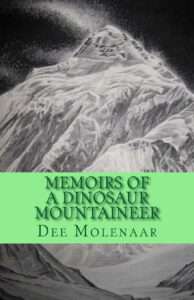
“Memoirs of a Dinosaur Mountaineer” is a memoir by the American mountaineer, scientist, and writer Kelly Cordes. It was published in 2021 and tells the story of his adventures in mountaineering and his work as a geologist and dinosaur tracker in the American West. The book received positive reviews for its combination of outdoor adventure, science, and personal reflections.
“The Challenge of Rainier: A Record of the Explorations and Ascents, Triumphs and Tragedies, on the Northwest’s Greatest Mountain” written by Dee Molenaar. It was first published in 1971 and provides an account of the history of mountaineering on Mount Rainier, the highest peak in the Cascade Range of Washington State, USA. The book covers the first recorded ascent of the mountain in 1870 and the subsequent mountaineering expeditions, including triumphs and tragedies. Molenaar, a noted mountaineer and artist, was involved in many of the ascents on Mount Rainier and provided detailed illustrations for the book. It is considered a classic in mountaineering literature and provides valuable insights into the challenges of climbing one of North America’s iconic peaks.
Ways to the Sky: A Historical Guide to North American Mountaineering
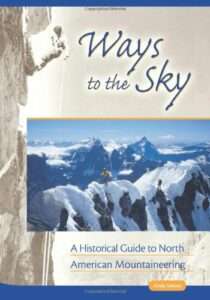
“Ways to the Sky: A Historical Guide to North American Mountaineering” is a comprehensive guide to the history of mountaineering in North America. It was written by Andy Selters and published in 2004.
The book covers the major peaks and ranges in North America, including the Rockies, the Sierra Nevada, the Cascades, and the Alaska Range, as well as lesser-known areas such as the Appalachian Mountains and the Mexican Volcanoes. Each section includes a history of the first ascents and significant climbs, as well as detailed information on the routes and challenges of each peak or range.
In addition to covering the technical aspects of mountaineering, the book also provides insight into the cultural and social context of climbing in North America. It includes profiles of notable climbers and their achievements, as well as discussions of the environmental and ethical issues surrounding mountaineering.
“Ways to the Sky” is a valuable resource for anyone interested in the history of mountaineering in North America, from beginner climbers to experienced alpinists. It provides a fascinating look into the evolution of mountaineering as a sport and its impact on the North American landscape.
“First Ascent” by Stephen Venables
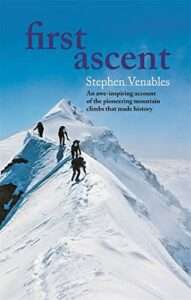
“First Ascent” is a book written by Stephen Venables, a British mountaineer, and writer. The book was published in 1991 and recounts Venables’ harrowing experience of climbing Mount Everest via a new route in 1988.
In “First Ascent,” Venables describes the challenges he faced while attempting to climb the highest mountain in the world via the West Ridge, a route that had never been climbed before. He describes the dangers of the route, including the steep and unstable terrain and the risk of avalanches. Venables also writes about the physical and mental challenges of climbing at high altitude, as well as the camaraderie and teamwork required for such an endeavor.
One of the most dramatic moments of the book is Venables’ solo descent from the summit of Everest, after he became separated from his climbing partner during a storm. The descent was a remarkable feat of endurance and survival, and Venables’ vivid description of the experience makes for compelling reading.
“First Ascent” is a gripping and inspiring account of one of the most challenging feats in mountaineering, written by a skilled storyteller who was intimately involved in the events he describes. The book is widely regarded as a classic of mountaineering literature and has been praised for its honesty, humility, and insight into the nature of adventure and exploration.
Tales of a Western Mountaineer
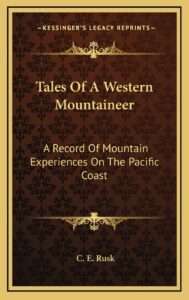
“Tales of a Western Mountaineer” is a book written by American mountaineer and author, Maurice Isserman. The book was published in 1982 and is a collection of essays and stories about Isserman’s experiences as a mountaineer in the western United States.
In the book, Isserman describes his early climbing experiences in the Cascade Mountains of Washington and Oregon, as well as his adventures in the Rocky Mountains, including the Tetons and the Wind River Range. He writes about his relationships with other climbers, the challenges of climbing at high altitude, and the thrill of reaching the summits of some of North America’s most iconic peaks.
“Tales of a Western Mountaineer” is not just a book about climbing, however. Isserman also reflects on the history and culture of the American West, and his essays touch on a wide range of topics, from Native American history to the environmental impact of climbing.
The book is notable for its engaging and vivid writing style, which captures the excitement and beauty of the mountain landscapes that Isserman has explored. “Tales of a Western Mountaineer” is a must-read for anyone interested in mountaineering, the American West, or simply good storytelling.
“Touching the Void” is a non-fiction book by Joe Simpson, published in 1988. It recounts the harrowing experience of Simpson and his climbing partner Simon Yates as they attempted to climb the west face of Siula Grande in the Peruvian Andes in 1985.
During their descent, Simpson suffered a severe leg injury, and Yates was forced to make the difficult decision to cut the rope connecting them in order to save his own life. Believing that Simpson had fallen to his death, Yates continued his descent, while Simpson was left alone and stranded on the mountain.
Despite his injuries, Simpson managed to crawl and hop his way back to base camp over several days, encountering numerous life-threatening obstacles along the way. His journey is a testament to his extraordinary will to survive and his remarkable courage in the face of extreme adversity.
The book has since become a classic of mountaineering literature, and has been adapted into a documentary film of the same name.

